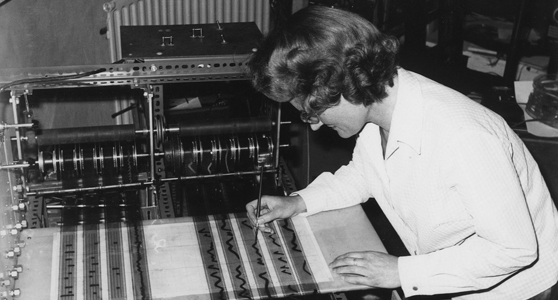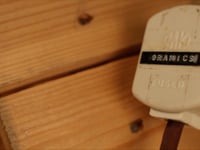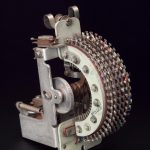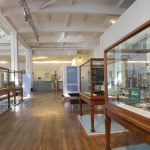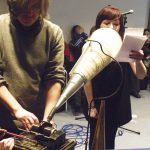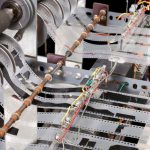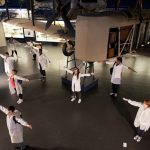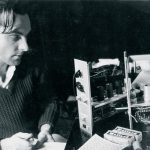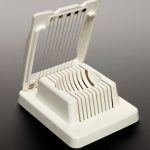Oramics to electronica: investigating lay understandings of the history of technology through a participatory project
Abstract
https://dx.doi.org/10.15180/140206/001Oramics to Electronica was a 2011 Science Museum project designed to put the tools of museum participation in the service of research into public history, taking the history of electronic music as our example. The primary output was a temporary exhibition. Whereas the term ‘public history’ is often used to denote popularisation of academic history, in this inflection we are primarily concerned with how lay people like our visitors think about the past in general, and about the past of science and technology in particular. Taking the opportunities that arose, we worked with two ‘expert’ groups – of original 1960s participants in electronic music and of 12 recruited present-day music enthusiasts. We also enrolled a group of theatre students and another of writers to respond to the themes of the project and, in particular, to the ‘Oramics Machine’ a unique sound synthesizer created by Daphne Oram. In this essay, an account of our practice is bookended with consideration of related practice and reflections on the implications of the project. It is suggested that the project demonstrated the virtues of proceeding by way of engagement with micro-audiences to understand the ‘cognitive exclusion’ of potential visitors who do not see their interests represented in museum displays.
Keywords
co-creation, co-curation, Daphne Oram, Oramics, public history, Science Museum
Introduction
https://dx.doi.org/10.15180/140206/027At the most basic level, museums are institutions that place collections in the service of audiences. Historical collections can be of value to museum visitors in countless ways, many – perhaps the majority – of which relate to how they understand the past in general, and in our case here, the past of science and technology in particular. In that sense, museums are part of the phenomenon known as ‘public history’, a term with many nuances of usage, ranging from top-down popularisations by academic historians via many types of cultural consumption, of museums, heritage attractions, magazines and broadcasts, to bottom-up amateur historical research. (Jordanova, 2006, pp 141-71; de Groot, 2008). The rationale for the Science Museum Group’s public history programme is to develop our understanding of this field, both because we are actors in the public presentation of history, and because the historical knowledge and beliefs of visitors that exist before they enter the museum are vital determinants of their experience. In other words, our programme is about both the ‘broadcast’ and the ‘reception’ of public histories. We are optimistic that from better understanding will flow more effective museum practice.
Our public history research programme is composed of a series of connected investigations that seek to deepen our understanding of this field. Our first significant experiment was, in 2011, Oramics to Electronica: Revealing Histories of Electronic Music, a project that involved several different kinds of participation involving different audience groups, producing both an exhibition and museum programmes.[1] In this, participation with the selected groups was equally designed to reveal the historical thought styles of the groups involved, and to facilitate the creation of the exhibition. The approach was one of co-curation (discussed below), on the grounds that there is a conceptual kinship between public history and co-curation that enables the latter to give insights into the former (Boon, 2011a). By providing a deeper, more practical, level of involvement, it also proposes new registers of public historical participation beyond those discussed by David Thelen in the classic public history text The Presence of the Past. His model of historical participation as it relates to museums is much more ‘downstream’ than that in our project; the respondents to the survey on which the book is founded were active historical participants in the sense that existing museum displays enabled their empathetic engagement with the past. (Rosenzweig & Thelen, 1998, p 195). In our project they were active historical participants because they co-created the account that appeared in the museum’s exhibition and public programme; their interpretations were public rather than private.
Sharon Macdonald states that a museum is ‘a suggested way of seeing the world’ (quoted in Onciul, 2013, p 81). No museum display is an objective statement; exhibitions always express the particular accounts of their subject chosen by their authors, whether the view selected – in objects, pictures, texts and other media – is that of the lone curator or the corporate voice of exhibition teams. In either case, there has, in many museums, often been an institutional impetus to render the story embodied in the show ‘clean’, unitary and consistent. Such exhibitions might be said to have a ‘monophonic’ voice. In the project under discussion, however, we set out to produce a ‘polyphonic’ exhibition; that is, one that expressed several different views of its subjects.
Our argument starts from the assumption that any museum display will have different meanings for different visitors. Personal knowledge, interests and experience mean that each of us brings something different to our encounter with displays. Within constructivist accounts proposed by authors such as George Hein (1995, pp. 21-23), displays enable visitors to construct their own accounts of the subjects. These accounts are different from visitor to visitor, and more detailed where the visitor’s enthusiasm for, and knowledge of, the subject depicted is greater. Congruently, Viv Golding suggests that ‘the situated nature of knowledge and the political positioning of museum authority […] can be challenged by the experience, beliefs, and emotions visitors bring with them’ (Golding 2013, p 13). It is appropriate therefore to be sceptical about the interest – even legibility – to museum visitors of the narratives embodied in exhibitions by exhibition makers. This in its turn is reinforced by the work of Michel de Certeau on the nature of cultural consumption (Boon, 2011b, De Certeau, 1984). He suggests that the consumers of culture are the agents of the meanings they construct. In his most memorable metaphor, he argues that consumers are like poachers; active on somebody else’s territory and grabbing what they want, a ‘rabbit’ that might, incidentally, be of little value to the ‘landowner’. If audiences grab what they want from our displays, then it is arguable that the embodied narrative we impose becomes – in the purest case – chiefly a matter of convenience to us in deciding what we’d like to put where. One of the present authors witnessed an example of this when partaking in an accompanied visit to the Science Museum.[2] When the family he was accompanying encountered the World War Two era V2 rocket in the Making the Modern World gallery, they discussed not the stories presented in the label – the beginnings of space flight and the slave labour used to manufacture the rockets – but the local history of Croydon, their home town, where many of these flying bombs had landed. This ‘different visitors / different meanings’ model has much in common with the ‘interpretative flexibility’ described by sociologists of technology, in which the same technological innovation may mean different things to different groups within society (Pinch and Bijker 1984). In the case of museum visiting, such individual interpretations are private, and only rarely accessible to museum staff. Oramics to Electronica sought to answer the question of how it would be if an exhibition were to be made starting with such different interpretations as well as being consumed in this way.
The work of narratologists is also relevant here; they use the term ‘story’ to denote a source, the set of events that may be represented in any narrative; ‘narratives’, by contrast, involve the conveying of the events in the story in alternative ways, not necessarily in the same sequence (Cobley, 2001, pp. 5-6, Boon, 2008, pp. 27-8). Our proposal was to make an exhibition that started from the assumption that visitors construct their own narratives in a self-directed (and not necessarily conscious) bricolage that combines exhibition contents and their pre-existing modes of thought. The corollary in the production of displays is that it makes perfect sense to include multiple narratives, reproducing in the Museum the tangle of narratives and information that we daily encounter in that deeply insanitary and engaging place, the external non-museum world.
Our experiment could be seen as addressing some of Laurajane Smith’s concerns about the ways in which ‘the authorised heritage discourse (AHD)’ – a heritage of country houses and similar attractions – places constraints on whose material history counts as heritage. As she argues, ‘much of that the debate is centred on a concern about getting more people to come to authorised heritage, rather than to considering if the heritage that we save and promote as heritage actually is representative of the diversity of historical and contemporary social and cultural experiences’ (2009, p4). In the Oramics project, we started with a subject area and focus object far distant from Smith’s AHD and proceeded ‘to embrace a wide range of cultural practices and values’ (2009, p 1). This recognised that people with different backgrounds will engage with cultural content in different ways (Smith, 2009, Crooke, 2010, Chitty, 2011). Unlike Smith’s focus, however, our project did not concentrate primarily on the social exclusion of classes and ethnicities, but on what might be termed the ‘cognitive exclusion’ of a subject –electronic music – outside the AHD but significant to individuals and subcultures. In this, our approach also differs from the weight of the museum participation literature, which reveals three dominant uses of participation in museums: the engagement of local community groups, empowerment of minority groups, and collaboration with source communities or indigenous groups. For Bryony Onciul, participatory projects are ‘engagement zones’; ‘every engagement zone is unique because of the individuals involved, as well as the context, time, place, and amount of power shared’ (Onciul, 2013, pp 81). What this meant in our practice will become clear as we describe the various sub-projects in more detail. If, as Onciul suggests, ‘museums are political spaces where society frames its authorized culture, history, and identity’ (Onciul, 2013, p 81), then projects like ours can be seen to challenge the arbitrary constituents of the AHD.
Participation at the Science Museum
https://dx.doi.org/10.15180/140206/002Over the last decade or so, a growing number of museums have attempted to engage lay publics with the work they do, inviting them to take part in the exhibition making process (Watson, 2007; Simon, 2010; Golding and Modest, 2014).[3]This practice has been known under many different names, including collaboration, participation, co-production and co-creation. Although these words are often used as synonyms for the same practice, it is also the case that a word such as ‘participation’ can be interpreted in many different ways. In her book The Participatory Museum, Nina Simon (2010, pp 185–87) attempts to create a meaningful vocabulary by identifying and naming three different types of public participation. For this she uses a citizen science model developed in 2009 at the Centre for Advancement of Informal Science Education and described in a report of that year (Bonney et al., 2009). The three types of public participation identified by CAISE are contribution, collaboration and co-creation. One could speak of contribution when visitors can share stories, comments or perhaps even objects within an exhibition. When visitors are given the opportunity to decide on the content of an exhibition within a clear framework designed by the museum, this can be called collaboration. Co-creation refers to a situation where members of the public and the host organisation together define the goal and content of an exhibition. Simon continues by adding a fourth model: hosting, in which case the host organisation provides resources for a community group to create its own exhibition or programme. Although these models could be taken to describe different levels of engagement, Simon stresses the fact that one isn’t necessarily better or more advanced than the other; the suitability of each model depends on the museum context, subject matter and goal of the project in question. It could be argued, however, that co-creation can be the most challenging form of participation from a museum perspective; it is certainly likely to be the model with the greatest impact on the organisation as a whole, as it requires ‘an overall rethinking of museum priorities and modes of action’ (Varutti, 2013, p 70). Participatory practice is firmly embedded within the Science Museum’s public history programme, and this is indicative of a Museum-wide commitment to developing high quality opportunities for participation. Of the four models of participation described by Simon, the Museum is focusing on participatory projects involving contribution, collaboration and co-creation. The Museum’s staff are seeking to include such practices in many of its projects, where laypeople are offered opportunities for participation at all stages of the development process.
At the Science Museum these fairly recent developments build on almost two decades of experience of participatory projects and experiments. Throughout this time the roles and goals of participation have changed considerably. As a response to a growing interest in the public understanding of science in the mid to late 1980s, the Science Museum started to explore its potential role as a venue for debate in addition to its traditional educational role (Boon, 2010a, pp 125–6). One of the relevant early experiments undertaken by the Museum, a consensus conference organised in 1994, stands out for two reasons: firstly, it was an event that had no links with the Museum’s core historical offer. Rather, it aimed to place the Museum at the centre of a wider movement of Public Understanding of Science, with permanent contemporary science galleries coming later. In other words, although organised by the Science Museum, it seemed to emphasise the role of the Museum as a physical location rather than the Museum in its traditional roles. Secondly, the event had a highly political connotation: it facilitated investigation of plant biotechnology by a lay panel recruited by the Museum during a period of high public anxiety about genetically modified foods. It resulted in a report written by the panel that was disseminated among policy makers, scientists and journalists (Durant, 1995).[4] The opening of the Museum’s Dana Centre in 2003 introduced a different opportunity to engage the public with contemporary science through debate and discussion. This was very much in tune with the House of Lords Select Committee report in 2000[5] which promoted a dialogue model for the public understanding of science.[6] The Dana Centre was designed as a venue ‘where the museum could run exciting, informative and innovative debates and other types of performances about contemporary science, technology and culture for an adult audience’ (Ellis, Patten and Evans, 2005). Being located in a separate building, and conceived of as an evening event programme (with a bar) meant the Dana Centre’s mode of public participation was being developed in parallel with, rather than as part of, the Museum’s existing offer, yet its opening demonstrated the Museum’s interest in facilitating public participation and debate, at least in areas of contemporary science. The Museum has also extended audience participation to its main galleries, especially (but not exclusively) those located in the Wellcome Wing dedicated to contemporary science. In the regularly updated Antenna gallery, visitors are asked for their (informed) opinion on a wide range of subjects that are discussed in the displays, such as the MMR vaccine or the deployment of military drones. Visitors can share their thoughts on the subject and read comments from other visitors and scientists through an on-gallery kiosk close to the exhibit. Visitor comments are included on screen after moderation. The updated version of the permanent neuroscience and genetics gallery Who Am I? exploring ‘the science of you’ opened in 2010. It includes a display case containing material co-created by various groups. At least once a year a new group is invited to give their views on subjects discussed in, or related to, the gallery (Tyrell, 2010).[7]
Evidently, participation had been on the agenda at the Science Museum for several years. Not surprisingly, many of these participatory projects were developed to enhance social inclusion and diversity, allowing more and different voices to be heard apart from the traditional ‘Museum voice’. Most of these projects originated from the Learning and Audience Development department. Social inclusion was also of importance for Oramics to Electronica, but this project varied from previous experiments in a number of ways. Firstly, and most importantly, it was part of the public history programme. As we have argued, one of its two main goals was to gain better knowledge of how different audiences understand and interpret the history of a specific subject, in this case the history of electronic music. It also differed in the sense that it worked with a wide range of audiences (experts, non-experts and people who had been part of the history we were exploring), it worked with them in a wide range of ways (online and off-line, in workshops and discussion groups) and it worked towards a variety of outcomes (a play, fictional monologues, a piece of music and exhibits). Finally, this project was curator-led, with support from the Museum’s Audience Research department, rather than initiated by the Contemporary Science or Exhibitions teams. For this reason, our terminology – parallel with Simon’s categories – was ‘co-curation’, to denote the way that we conceived of this register of participation as the sharing of curatorial responsibilities and skills.
Enabled by the recent historical focus (post-1950s) of our topic, we were able to engage a diversity of individuals and groups who could be asked to produce their own accounts of the history of electronic music. The process of the project, executed as an open-ended and opportunistic research enterprise, allowed us to respond to opportunities as they arose. But for clarity it is simplest to abandon the opportunistic sequence followed in the project, and to organise this account by describing working with four kinds of participatory group: the Daphne Oram Archive; subject experts (two groups); non-expert socially excluded communities (two groups); and global online participants.
Daphne Oram Archive
When the exhibition was conceived, the proposed centre-piece for the exhibition – the Oramics Machine synthesizer – had recently been acquired with the collaboration of the Daphne Oram Archive at Goldsmiths, University of London. It was therefore natural to work with staff and archivists there on initial narratives about the machine.
Expert groups
Some of Oram’s contemporaries were available to share their memories of their ventures in modern music in the 1950s to 1970s. This was complemented by convening a group of present-day electronic music enthusiasts. By having these two groups involved, it was possible to create two different ‘expert accounts’ of the early years of electronic music, one from music enthusiasts and one from the people who were part of the early electronic music ‘scene’. A film by Nick Street and Jen Fearnley summarises these two strands of participation.
Non-expert groups
The Museum also worked with two ‘socially excluded’ groups who were unfamiliar with Oram’s work before the project – members of a National Youth Theatre course, which aimed to re-engage young people excluded from education – and a group of women writers affected by the criminal justice system. Instead of asking these groups to create an alternative historical narrative for a subject matter that they might not feel a connection with, the team decided to invite them to respond to the story of Oram and the history of electronic music in more creative ways.[8]
Global online groups
In addition, the Museum created an online co-creation project in the form of a Facebook page and a remix competition directed at electronic music ‘fans’.
In total, therefore, the project had four participatory strands, three of which were based around knowledge sharing, and one of which focused on creative re-appropriation of an unfamiliar history. All can be seen as speaking to the project’s public historical concerns, revealing how different individuals and groups think about the history of electronic music.
In the remainder of this essay, we describe how each main participatory strand originated; how we worked with the group in question, and what we learned. The conclusion summarises our findings and proposes a set of further research questions that arise from this programme of work.
The Daphne Oram archive
https://dx.doi.org/10.15180/140206/003The background to the project was that in 2010 staff at the Museum set out to develop its public history research in the context of two planned gallery redevelopments, on the histories of science and of communications.[9] Electronic sound was, at that stage, proposed to feature as a section of the latter gallery. The Museum had just acquired Daphne Oram’s unique and extraordinary Oramics Machine synthesizer for its collections. We proposed that this should be the focus of our endeavour, partially because of its intriguing appearance – a perpetual prototype built on a very limited budget incorporating a mass of Dexion racking, wires, switches, strips of 35mm film and, indeed, a broom handle. Oram had been a founder of the BBC’s Radiophonic Workshop, where she was one of a small number of significant women within this experimental department. Here composers and engineers worked together with often ground-breaking results, to create sound effects, jingles and soundtracks for radio and television shows, perhaps most famously for the science fiction series Doctor Who (Niebur, 2010). The Oramics Machine was the fruit of Oram’s determination to create a device that would translate drawings into sound, a pursuit that had led her to leave the BBC in 1958 and set up her own music studio.
As the machine had been acquired with the collaboration of the Oram Archive and its curator Mick Grierson (Grierson and Boon, 2012, pp 186–7), it was natural to work with the team there. Our original wish had been to ‘grow’ the exhibition on gallery, with several successive developments as new narrative points of view were added. Practicalities resulting from the very active schedule of the Museum’s design and workshop departments meant that there were, in the end, only two phases. The first, opened in July, presented the machine, along with a single display case on tape music technique, a computer information point written by Oram Archive associate Chris Weaver, a gallery version of the iPhone Oramics App developed by Parag Mital and Mick Grierson, and a series of archive photographs of Oram. This version was very much a product of the collaboration with the Goldsmiths team; apart from reference to Louis Niebur’s (2010) then new book on the history of the Radiophonic Workshop, Goldsmiths was the prime source of the account. In this sense, it was co-created with them.
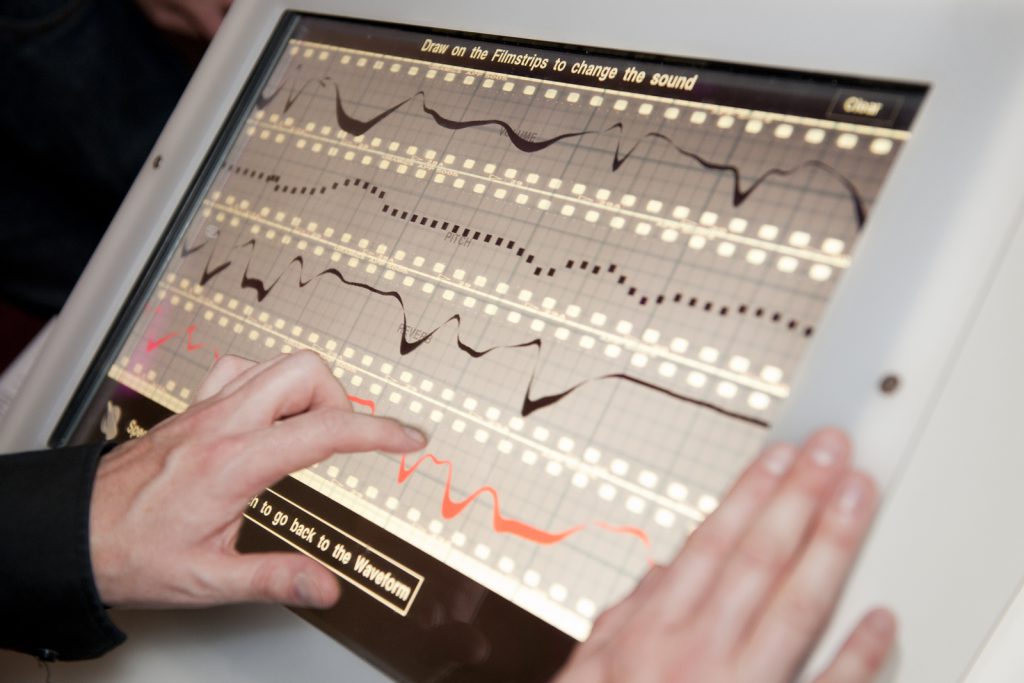
Expert group 1: original participants
https://dx.doi.org/10.15180/140206/004Given Daphne Oram’s death in 2003, a participant account from her was evidently impossible. But the ambition of Oramics to Electronica had consistently been to go beyond the work of Oram and to situate it in the broader history of electronic music. It was on this basis that we invited people who had worked at two organisations contemporary with her work – the BBC Radiophonic Workshop and Electronic Music Studios (EMS) – to participate in the project on the basis that a showcase each would be devoted to their stories. The two groups were engaged together so as to explore overlaps and linkages that might have occurred in the period under consideration. It was also hoped that this approach would reveal aspects of the history that were not already on record.[10]
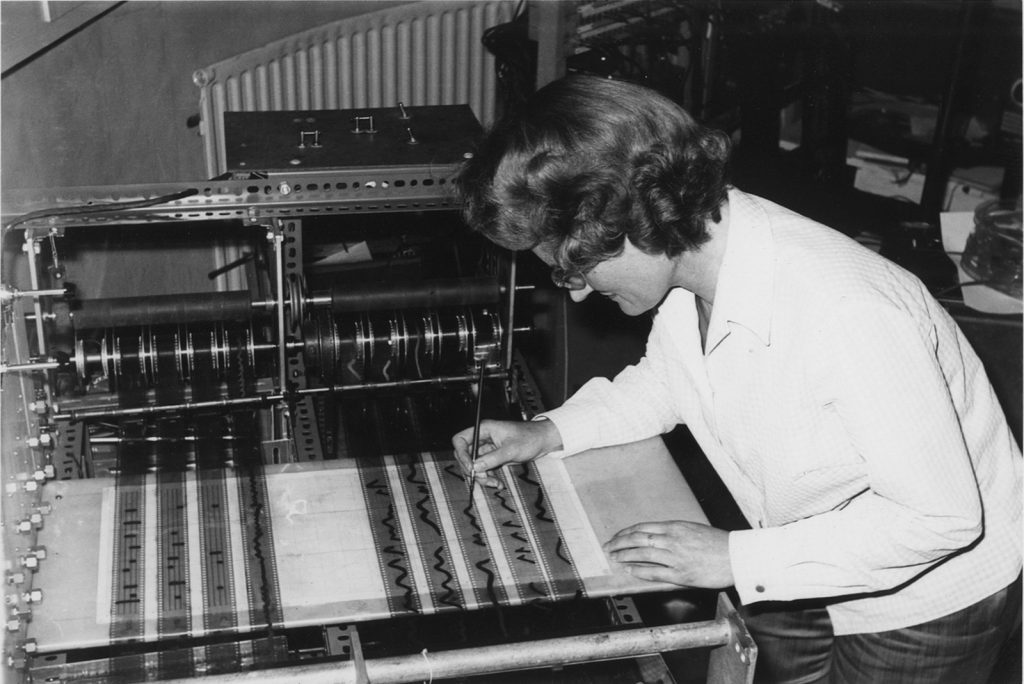
Although it was not practical to convene these original participants on a regular basis,[11] the sessions were of great value, revealing contrary to expectations that the musical interests of the two groups had diverged rather than converged after EMS sold synthesizers to the Radiophonic Workshop in the 1970s.[12] The less intensive nature of the work with these original participants (as compared with the present-day music enthusiasts) required a more mediated approach to what would actually appear in the final exhibition. In this sense, these displays were closer to a conventional curator-led display than the others, though in this case the curator acted deliberately in the role of mediator rather than author. In each session, the participants were invited to discuss the interactions of technical means and musical possibilities in the 1960s and 1970s. These gave rise to curatorial proposals about what might be displayed. The accompanying label texts in the final exhibition were all abbreviated quotations from the discussions (which were being recorded on Dictaphones and by Nick Street for the project film – see Oramics to Electronica documentary). This approach was intended to combine the wish for these displays to embody an autobiographical account of the subject without making undue demands on these participants.[13]
In relation to the public history question about how visitors view objects from a position of expertise, working with this particular group enabled correction of the ‘standard account’; the witness of these participants altered the narrative we might have conveyed. We know that every day people see objects in the Museum that have personal significance, ranging from the social history appeal of ‘didn’t we used to have one like that?’ to the late career scientist encountering on display a piece of unique apparatus from early in their career. One difference that the co-production technique enabled here was an interaction that introduced new objects into the account of the appropriate type. For example, one significant original participant told a story about making crude electromechanical sequencers using uniselectors (telephone exchange electromagnetically-actuated switches); it was possible to include in the display such an item from the Museum’s telecommunications collection.
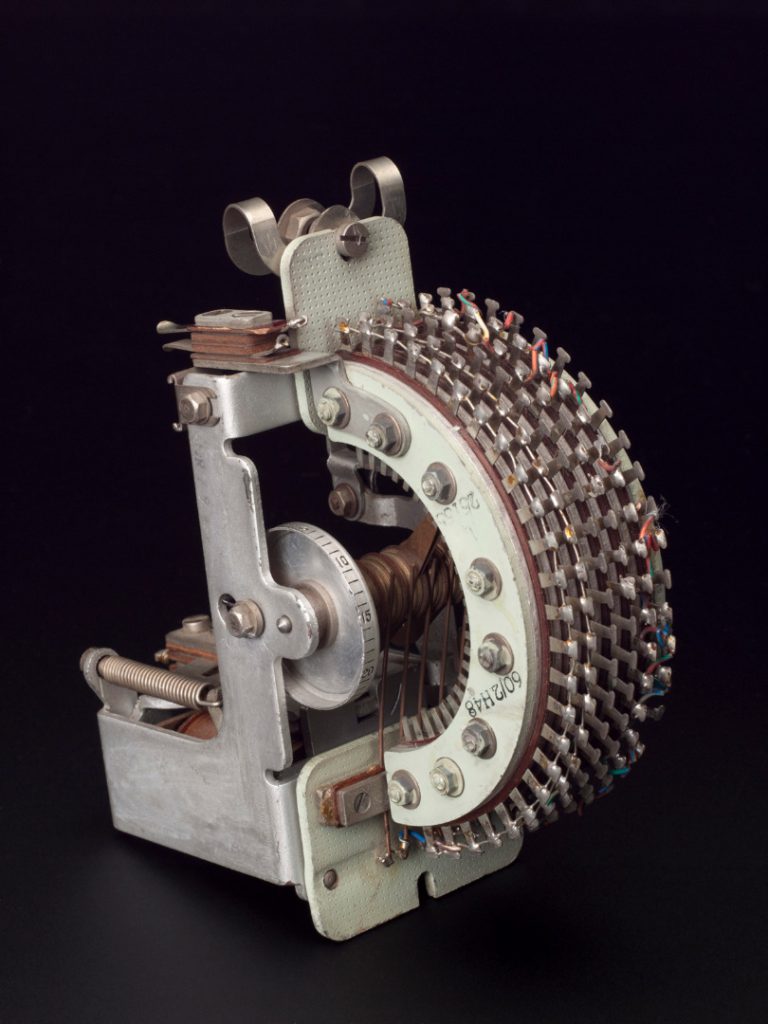
Similarly, discussions with a member of the original EMS team who now runs a business repairing EMS equipment, enabled the acquisition and display of several prototypes and early products of the company. In other words, the close co-production model went beyond normal Museum practice to create both a richer account and stronger collections for the future. The displayed account, though highly concise, contained a deep inflection of autobiographical insight.
Expert group 2: recruited music enthusiasts
https://dx.doi.org/10.15180/140206/005Early in this collaborative project, it was decided to recruit a group of present-day music enthusiasts. The initial thinking within the public history programme was to explore lay perceptions by working with groups that could be expected already to have a developed sense of the past – family and local historians, subject enthusiasts and collectors. The exact role of the music enthusiasts was not pre-defined in detail, as it was thought important that they be enabled themselves to define what the collaboration should look like.
The Museum had not worked with this audience group before and did not have access to a music enthusiast community. This meant that it was possible to bring together a heterogeneous group, representing a wide range of musical tastes and preferences. For this reason it was decided to recruit individuals rather than to work with an existing group. Recruitment took place online, through the Science Museum blog and social media channels and in collaboration with The Wire, a music magazine with a strong online presence. Because the Museum intended to facilitate substantial involvement in the development of an exhibition, a rather large time commitment was requested from potential candidates. Participants were asked to be available to travel to the Museum’s London site on Tuesdays in the months of June and July 2011 to attend a series of workshops and behind-the-scenes visits. The Museum wanted the project to be accessible to as many members of the target audience as possible, but was aware that the required time commitment from participants was likely to form a substantial barrier to participation for some. People in full time employment, for example, might not be able to attend a regular event on a weekday during working hours. Because of these constraints, the Museum was not expecting a large number of responses. Ideally a dozen music enthusiasts would be recruited, with the expectation that up to half of them might not finish the project due to conflicting time commitments or lack of interest. These expectations were based on the participation project experience of other museums, as well as in-house experience from previous co-creation projects. It was deemed important that the recruitment process itself was simple and clearly described and would not throw up any more barriers for potential participants by being complicated or time consuming. Interested candidates were asked to describe in up to 300 words why they loved electronic music, what kind of music they made themselves, how they shared it with others, and what knowledge they had of the history of electronic music. People were encouraged to interpret this brief creatively if they pleased and to use any writing style they were comfortable with.
The project team was astonished by the large number of high-quality and incredibly enthusiastic responses it received. More than 40 music enthusiasts from a wide range of backgrounds responded to the recruitment text. People from as far afield as the United States were keen to participate. Eventually, 12 people were selected. Their engagement with electronic music varied greatly. Throughout the selection process the Museum’s aim was to create a heterogeneous team, representing wide-ranging backgrounds, interests and skills. Some participants were (semi-) professional musicians, but most also engaged with the subject in a different way. For example, one member of the team was an academic in the field of electronic music, another a professional music writer and a third built his own circuit-bent[14] instruments. The participants also represented a wide range of genres within the field of electronic music. Some favoured soundscapes, minimal, or drone music, others more popular genres such as dub-step or synth-pop. During the first workshop, when all participants met for the first time at the Science Museum’s small objects store, each participant was asked to play some of his or her own music. It was interesting to see how, after talking about their passion for electronic music and discussing the project, sharing their music proved to be a highly effective tool for introducing themselves.
Over the course of six half-day sessions the team of music enthusiasts developed the contents for three display cases in the exhibition. The project team thought it important that participants could leave their mark not only on the end product – the exhibition – but also had shared control over the level of participation and the participatory process. It soon became clear that almost all participants were highly engaged and very motivated to work on the project, both during and in-between scheduled sessions. This meant that the project team had to spend more time preparing the sessions, and providing extra information and ‘homework’ via email, but as a result a much higher level of collaboration was achieved than was originally expected.
The enthusiasts were very interested in the exhibition-making processes that existed at the Science Museum. What teams were involved? What did they do? How is an exhibition usually made? It became clear that the participants felt they had to understand the process in order to contribute fully to it. Although there was some initial hesitation within the public history team, as they worried that providing this information might guide their thinking too much, it was decided that it was only fair to provide the participants with the information they requested. Corinne Perkin describes this process as the ‘mediatory role […] in providing professional advice and guidance’ (Perkin, 2010, p 117). Indeed, there is a fine balance between informing a group of participants of the boundaries that exist with regards to available budgets, the space of the site and the time available, and giving them equal control of the exhibition-making process. We would argue, though, that choosing not to inform participants of the possibilities and limits (and why we might do this) actually makes them less embedded in the project, with the final proposal potentially being unviable and, as a consequence, participants being disappointed when they find out that the Museum did not develop the exhibition they had envisioned. Bernadette Lynch (2011) warns of ‘empowerment-lite’ and argues that sharing power equally is pivotal. Lynch and Alberti (2010), Simon (2010, pp 274) and Govier (2009) all describe ‘radical trust’ as being of utmost importance for co-creative projects to be successful. However, Simon also states: ‘Successful co-creative projects scaffold participation’ (ibid, p 269), emphasising that participants need to be supplied with the tools they need to make the project a success. As Onciul (rightly) states, although radical trust can be a powerful tool for co-creative practices, it is not always feasible because of a variety of limitations, such as the ones described before (Onciul, 2013, p 93). One could say that truly sharing power means sharing responsibilities as well.
Sessions with this group were split between the Science Museum’s Blythe House small object store in West London and the main Museum site. This phase included visits to the Oramics Machine when it was still in storage, the Museum’s acoustics and sound reproduction storerooms, the conservation laboratory, and the exhibition space. Participants were shown films about electronic music from the 1960s and 1970s and met several specialist Museum staff to learn more about the exhibition-making process. After general discussions about the history of electronic music and a workshop session aimed at mapping themes, people and genres, the team worked on a message document for the exhibition, which outlined the main message of their section of the exhibition. (‘Message documents’ have been part of the standard approach to exhibitions used at the Science Museum for over a decade; they are brief, hierarchical statements of the themes an exhibition is intended to convey.) Based on this, and the mapping exercise, the team decided to move away from a chronological display and instead chose three themes, one for each display case, to represent different aspects of the production of electronic music. The team was keen to share their enthusiasm for making electronic music, as well as its history, with young people and non-experts and their choice of themes reflected this. Each theme focussed on an aspect of the music-making process and in a sense was musician-centric, rather than highlighting technological changes.
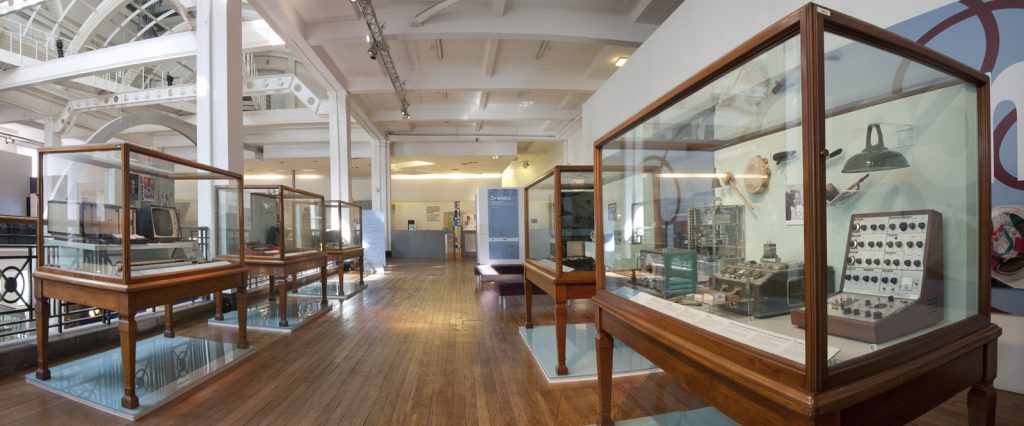
The theme Democratisation of Electronic Music discussed how the availability of home computers, cheap synthesisers and (sometimes bootlegged) home studio software, enabled the making of electronic music, rendering it more accessible to an ever-growing number of people. In Make-do and Mend the electronic musician as tinkerer was presented. Objects in this display case included a toolbox, a circuit-bent children’s toy and an egg slicer that had been used by sound artist Hugh Davies.
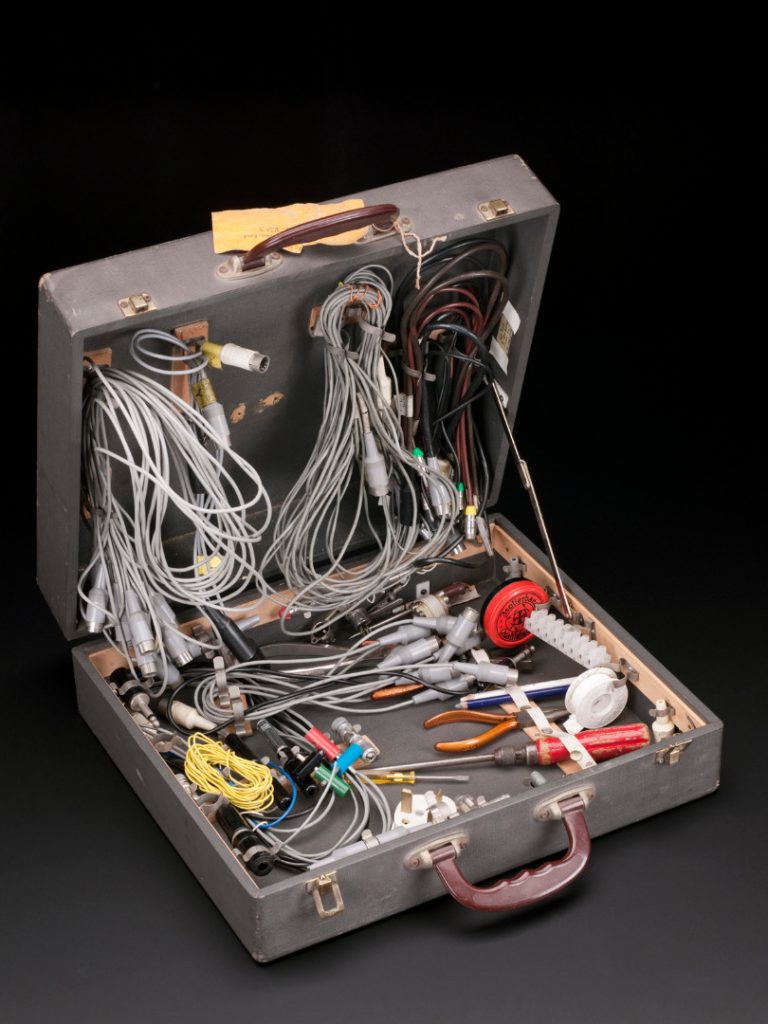
One clear example of how technological progress, often a meta-theme of Science Museum exhibitions, was made secondary to creativity was the inclusion of a Roland TB-303. This bassline sequencer, intended by its manufacturers to be an accompaniment for solo musicians, had been a huge disaster from a commercial point of view. It was unpopular and soon taken out of production, appearing on the second-hand market shortly after its launch. Unexpectedly, it was picked up by musicians in Detroit and Chicago who discovered that if they pushed the machine to its limits its sounds would change into high-pitched ‘liquid’ rhythmic noises, the new kind of sound they were looking for. Despite the machine’s initial commercial failure, the birth of Acid House, a music genre enjoyed by thousands, depended on the TB-303.
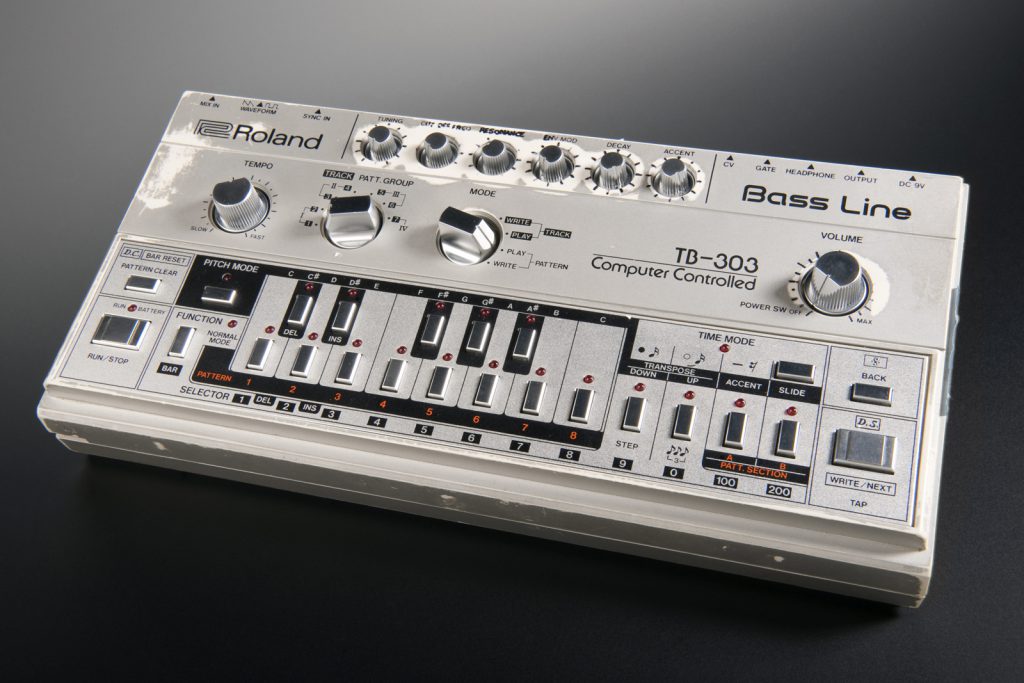
Finally, the theme Sonic Frontiers discussed how musicians not only searched for new sounds, but also new forms of composition, including the role of the then-emerging field of Artificial Intelligence. This focus on enthusiasm, creativity, and the endless search for new sounds, techniques and tools, rather than the traditional techno-centric story, has made an impact on the themes of the exhibition overall. It has also been an unexpected result of the Research and Public History department’s exploration into the way enthusiasts and lay experts engage with the history of science and technology subjects.
After this joint work had come to a conclusion, it became clear that several of the electronic music enthusiasts had formed a strong bond. They met and were in contact regularly outside the Science Museum sessions, and started making plans for joint musical ventures. They also made it known to the project team that they wanted to stay involved in the project. As a result, three of them co-wrote all the text labels for their three display cases, assisted by Science Museum staff, who also gave them a short label-writing training session. After the exhibition had opened, several of the team members gave talks and guided tours during one of the Science Museum’s Lates (a monthly evening opening for 18+ visitors) and a number of them performed during another Lates event.[15]
The project team learned much from both the musicians and the collaborative process itself. The enormous enthusiasm for the project from the musicians was impressive, but also brought home the great responsibility the project team had for providing a strong base for the project. Managing the enthusiasts’ (very high) expectations and finding an appropriate register of response when they questioned aspects of Museum policy – especially as to whether the instruments might be played – were important aspects of what the Museum team learned. Museum staff had to be flexible, think creatively and seek collaboration with colleagues from many teams to facilitate the participatory process. With regards to the public history questions about the way lay experts engage with the history of technology, the main insight was that the engagement tended to be less with the technology itself, and more on human endeavour, creativity and perseverance. It was not success that was deemed important, but the (creative) process in search of new possibilities, new sounds, new frontiers. This reinforced a tendency – visible over a long period – for the Science Museum to move away from collecting and researching objects only in terms of technological development. But the nature of the account the participants proposed was unexpected and novel; it was not, for example, chronological, or focussed on particular electronic musicians. The process revealed gaps in the Museum’s representation of electronic music in its collections. It also questioned the way the Museum collects and stores information about its objects. Perhaps most importantly, this experience challenged the Museum to see new narratives around its collections and to explore different approaches towards collections research.
Non-expert group 1: The National Youth Theatre
https://dx.doi.org/10.15180/140206/006An opportunity arose late in 2010 to work with young students from the National Youth Theatre. The particular group were studying on the ‘Acting Up 2’ access course, which provided opportunities to young adults who had been excluded, or who had excluded themselves, from formal education. The group’s ambition was to produce a theatrical performance on the Museum’s themes; the performance was featured as a public event in the Museum, with a video excerpt incorporated in the Oramics exhibition’s mini-cinema. As potential participants in the Oramics project, these students promised insights into how a group that could be expected to have an active listening experience of music might think about and respond to stories about electronic music, and to the invitation to work with the Museum. The core period covered by the exhibition – given that all of these students were born after 1985 – was outside their direct experience, so it was hoped to gain insights into this group’s sense of the historical aspects of the subject. The approach to the group was via a series of stimulus sessions; after a session introducing the aims of the project, the students enjoyed a hands-on workshop where the sound artist Aleks Kolkowski introduced them to analogue recording – on Edison wax cylinder, 78 RPM gramophone disc and 45 RPM single. In a subsequent session, Katy Price, poet, creative writing specialist and a co-author here, worked with the students to produce short written pieces, which were subsequently recorded by Kolkowski.
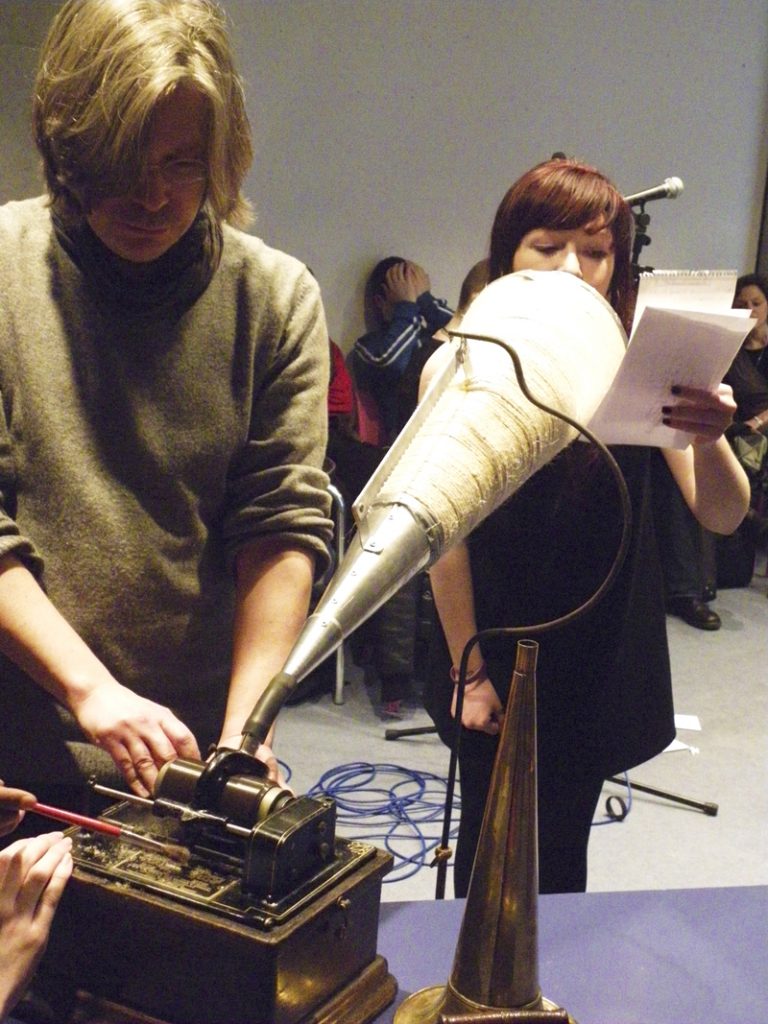
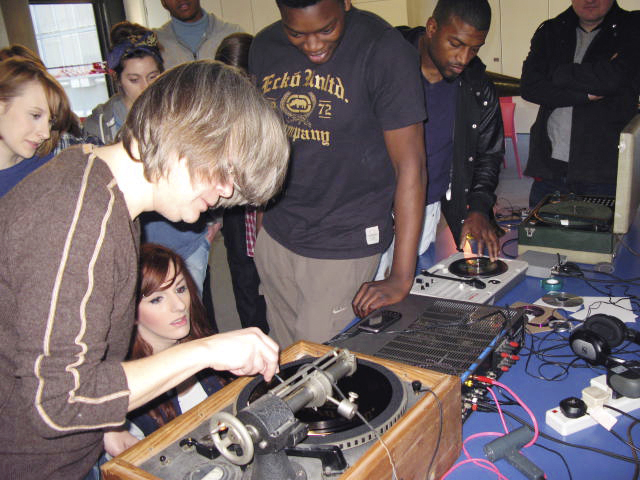
The group were also taken to the British Film Institute to see a selection of films and TV programmes, including the 1969 BBC documentary about electronic music The Same Trade as Mozart and two Geoffrey Jones films soundtracked by Oram, Snow (1963) and Trinidad & Tobago (1964). Finally, the group was taken to the Science Museum’s store at Blythe House in West London, where they were introduced to the recently restored Oramics Machine. Here, they also met Mick Grierson, keeper of the Oram Archive at Goldsmiths, University of London, who told them about Daphne Oram’s work and life, as well as explaining the workings of the Oramics Machine.
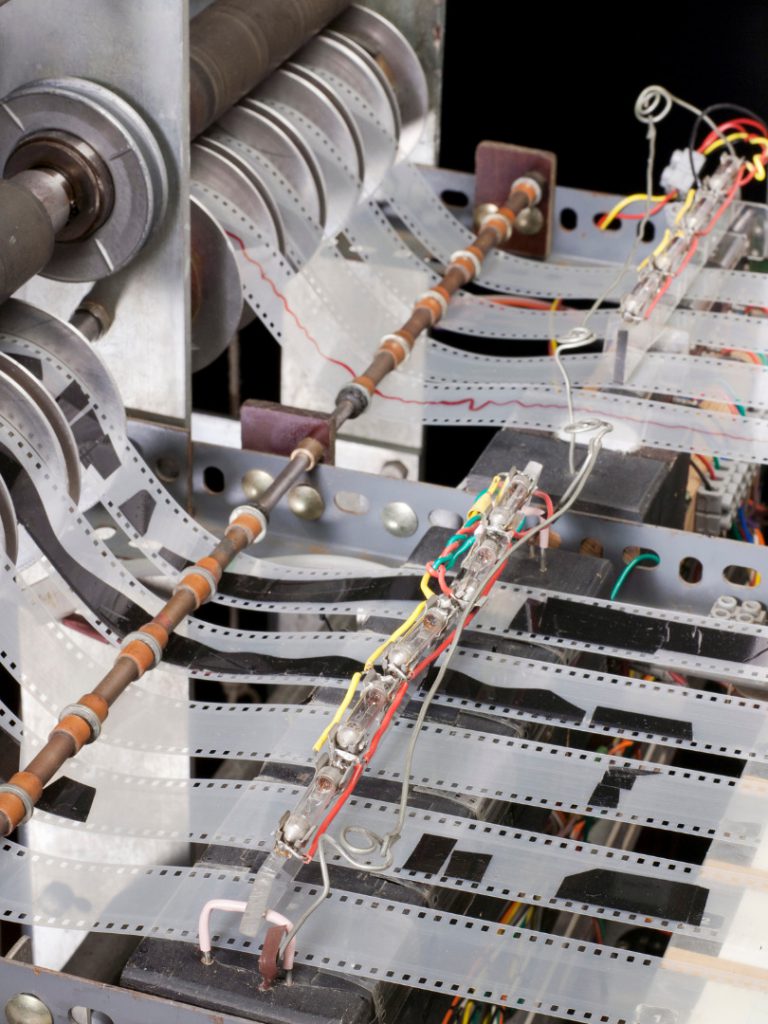
Armed with these stimuli, the group developed a theatrical performance they named In Search of Pioneers, which was performed to the public in the Museum’s Flight gallery in April 2011. The scenario for the piece, which included choreographed action sequences and a narrative of one participant’s resistance to Oram’s music, also focused on the importance, from the participants’ point of view, of recognising the significance of ‘unrecognised pioneers’, drawing the audience’s attention to other ‘pioneers’, including the pilot Amy Johnson (whose story is included in the Flight gallery). As Laurie Waller has suggested, ‘The NYT students’ performance emphasises the affinities of marginalised youth with experimental inventors; both are the “underdogs” bent on following their individual passion in spite of the hardship and social obstacles imposed on them’ (Waller, 2014, p 202). The main narrative of the performance was an argument between a group of ‘sound scientists’ and a second group of students, in which the scientists sought to persuade the students of Daphne Oram’s significance, which the students resisted on the basis that they have their own music (Ibid, pp 79–80).
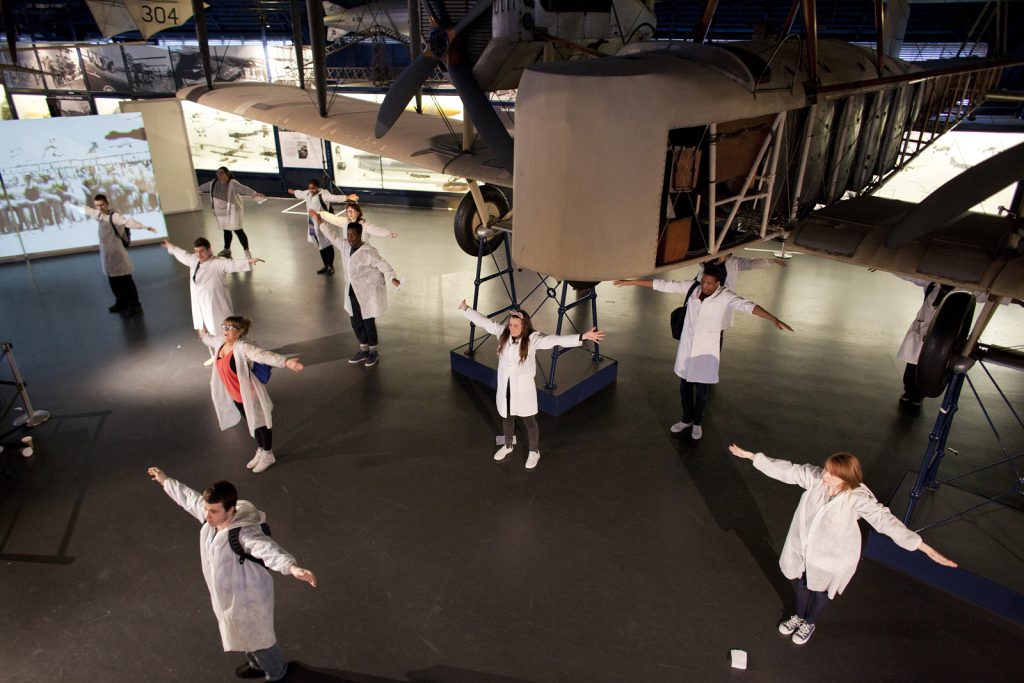
We may generalise from the evidence of the performance that this co-curating group brought a particular expertise about contemporary music that was at odds with the older kinds of electronic music at the core of the project. This, as literally expressed in the performance’s narrative, was inflected through a resistance to education; the characters they play didn’t wish to be co-opted to the priorities of the ‘sound scientists’. In the end, though, the ‘students’ in the performance co-opted Oram as one of their own. After having seen the performance, Mick Grierson expressed enthusiasm and surprise. He admitted he hadn’t expected the students would incorporate detailed scientific explanations and discoveries in their story, which they did. The play gave him a new understanding of how young people engaged with the scientific subject matter he knew so well.
Non-expert group 2: women writers
https://dx.doi.org/10.15180/140206/007Members of the exhibition team spent three days with a group of women writers, who became involved in the project with the help of the organization Clean Break, which runs writing courses to develop the skills and confidence of women affected by the criminal justice system. Our women-only workshops were led by established playwright Vivienne Franzmann, who was known to the women through her previous involvement with their organisation as a writing tutor. It was important, given the short amount of time that we had with the women, that they could work with someone they trusted and who was familiar with their capacities. Katy Price, who had previously run sessions with the NYT group, worked alongside Franzmann and was present in each session as a co-facilitator. The first day was hosted at the offices of Clean Break, so that we could introduce the new topic of electronic sound in an environment familiar to the writers and where they were used to being productive. Free-writing exercises revolved around the theme of invention, and in response to music clips, including some of Daphne Oram’s music. At this stage we did not introduce Oram or the Oramics Machine, preferring to wait until we visited the gallery on the second day (the machine had, by this stage, been installed on the gallery although the exhibition was not yet complete). The writers were introduced to the machine simply by arriving on the gallery as a group, and were invited to respond to it without any context or explanation. They began relating it to personal histories and concerns, for example associating the speakers with boom boxes and reggae culture, or surmising that the machine might be used for broadcasting ‘mind control’ and the capture of citizens’ thoughts. Follow-up writing exercises included monologues that imagined selling the machine to an auction house, and a workplace skirmish set at the BBC at dawn. These followed an introduction to Daphne Oram via a film clip. The writers had a very positive and intrigued response to Oram; despite their different cultural circumstances, these women related very warmly to her as a character.
The writers were encouraged to select anything they liked from the exercises of the first two days to develop into a monologue for performance and recording. Knowing that their work would be presented on gallery with the Oramics Machine, they were concerned about visitors’ experiences and the need to make their writing relevant to the themes of the exhibition. We tried to reassure them that this was a speculative project and that what we valued were their free explorations around the themes covered in the workshops. The final monologues, which expressed a range of the writers’ responses to technology and specifically to women’s experience, were performed by professional actors who had previously worked with Clean Break at a private event for its own staff and for female Science Museum staff involved with Oramics. The actors and writers then moved to the Imperial College radio station where a sound engineering student recorded and edited the monologues for inclusion on gallery. The recorded monologues were included in the exhibition by incorporating them in the sequence of items run in the display’s mini cinema.
The monologues explore themes of communication and isolation, discomfort and danger, discovery and experiment, dreams and incantations, and pressures on the body. Several of the scripts use sound in different ways to negotiate dramatic shifts or moves between strangeness and familiarity, arising out of workshop discussions about different ways that sound can enter writing. The core Oramics principle of visual sound emerges at moments of emotional intensity, such as the image of a swan taking off from a lake as a way to convey the sound of a heart beat, or the melding of flames and laughter. One monologue engages directly with an imagined daily routine for Oram and the experience of being almost at the breakthrough when the day job intervenes. Marvellously respectable on the outside, this monologue’s Daphne sneaks back into the studio at night to work on her invention: ‘I know the sound I’m trying to create. I’m so close I can taste it. …it’s light outside. Oh here’s the boss […] I’m going to have to soft soap him.’ In other scripts the association between sonic attention and dislocation from the everyday world is more menacing: ‘I could hear the crinkling noise of newspapers being turned, the “sceerpht” sound as the page scraped across the business man’s suit. It felt dreamlike, surreal, like Alice in Wonderland. I felt disconnected. My palms began to feel clammy.’
In one sense the findings from working with excluded women writers were practical. Time constraints relating to working with this group meant that the Clean Break workshops were delayed until the Oramics Machine was already on gallery, and so we were limited to three sessions on consecutive days. Issues to do with the funding of arts organisations and the provision of childcare were major factors in dictating the timing and extent of what was possible. Ultimately this meant that, in comparison with the other groups, the women writers were more ‘downstream’ in their participation, responding to an already displayed object. The opportunity for them to produce knowledge about the machine was channelled through the oblique address to Oram and sounds that we invited them to make through their creative work. Rather than featuring explicitly in gallery cases or labels, their personal histories evoked in response to Oramics were available to visitors through female-voiced narratives that take listeners through processes of memory and discovery.[16]
This way of proceeding was designed to resonate with Clean Break’s approach to its clients; presentation of the women’s work in a national museum can be seen as helping to fulfil the aim of building their clients’ self-confidence. From the point of view of the public history research question, these monologues revealed how objects can provoke meanings for – and make sense to – visitors, even where they are very remote from audience members’ pressing concerns or explicit interests.
Global online audiences via Facebook and Soundcloud
https://dx.doi.org/10.15180/140206/008As well as working closely together with (local) electronic music enthusiasts and original participants, the project team wanted to engage a global audience of electronic music enthusiasts. To this end the team set up a Facebook page and later organised an online remix competition. Both of these activities were seen as being of an experimental nature. Their main goal was not to attract large amounts of traffic, but better to understand if it was possible to engage people with the Museum’s work and collections through the use of social media and to discover how online audiences responded to various types of content.
Online audience 1: Facebook
https://dx.doi.org/10.15180/140206/009Rather than creating a Facebook page under the name of the exhibition, the page was named after the Oramics Machine.[17] It was thought that this would give the project team the opportunity to have a more personal and open tone of voice. The intended audience for the Facebook page was electronic music enthusiasts, and it can be argued that the sense of ‘exclusivity’ emanating from this page name contributed to its success.
Facebook can generate detailed statistics about the reach of a page, daily likes, most popular posts and much more. Although these statistics can be useful, we believe they say little about how people engage with content. Here we describe how the Facebook page was used to gain some insight into the nature of online audience engagement. The exhibition team used Facebook as part of our policy of openness about the exhibition-making process and used several techniques to achieve this. We shared pictures of the co-creation workshops and visits to the stores, of the work that was done on gallery and of our Conservation Lab preparing objects for display. Pictures generally work well on Facebook; sharing the process and progress in this way meant that we could on the one hand aim to excite people about the exhibition, but on the other be clear and honest about its modest size.
We encouraged the 12 music enthusiasts who co-created part of the exhibition to write blog posts about their experiences. They published these on their own blogs and we linked to them from the Facebook page. The blogs provided a means for others who followed us on Facebook to find out more about the exhibition-making process. Discussions and questions from the co-creation workshop were shared with Facebook followers. The Museum also successfully sourced loan objects for the exhibition through Facebook, such as an early version of the home studio software Cubase for Atari.[18]
After the exhibition opened, people were encouraged to share their pictures and experiences of their visit. Many responses were positive, some less so. The team sought to acknowledge all contributions and learned to take time to craft an honest and open response. Our experience here was that the people who posted negative comments did so because they cared a great deal about what the Museum was doing. It is important to acknowledge that, and to take time to respond to their concerns. In one case we managed to build up a strong relationship with somebody who first seemed to be posting rather negative comments. In this case, it turned out that criticism was a form of close engagement, and this individual ended up providing an object on loan for the exhibition. He was invited to the opening and contributed to the remix competition, being very supportive of other contestants in addition to entering the competition himself.
Besides opening up the exhibition-making process we also wanted to create a space for knowledge-sharing. One of our volunteers wrote a blog post describing how to make a tape loop using an old cassette tape, a pair of scissors and sticky tape. This post, which included sounds of the tape loops he had made himself, proved to be particularly popular. We also shared content from our archives that would not necessarily interest the general Science Museum public, if there is such a thing, but that was potentially of great interest to subject enthusiasts. One example of this was a scan of a Science Museum Lecture Report of a talk given at the Museum in 1982 by Dr Robert A Moog, inventor of the Moog analogue synthesiser.
We were hoping that people who ‘liked’ the page, and had a shared love for the history of electronic music, would start interacting with each other on the page itself, without needing the persona of the Oramics Machine as a moderator. It was challenging to establish this, partly because of the design and nature of Facebook, but it did happen occasionally. For example, somebody posted a comment that started with an enthusiastic review, but also included a question about some technical details regarding the Oramics Machine. We were trying to formulate an answer to that question, but soon discovered the comment had received a response from Graham Wrench, the engineer who built the prototype of the Oramics Machine for Daphne Oram. This resulted in an engaged conversation between the enthusiast and the engineer.
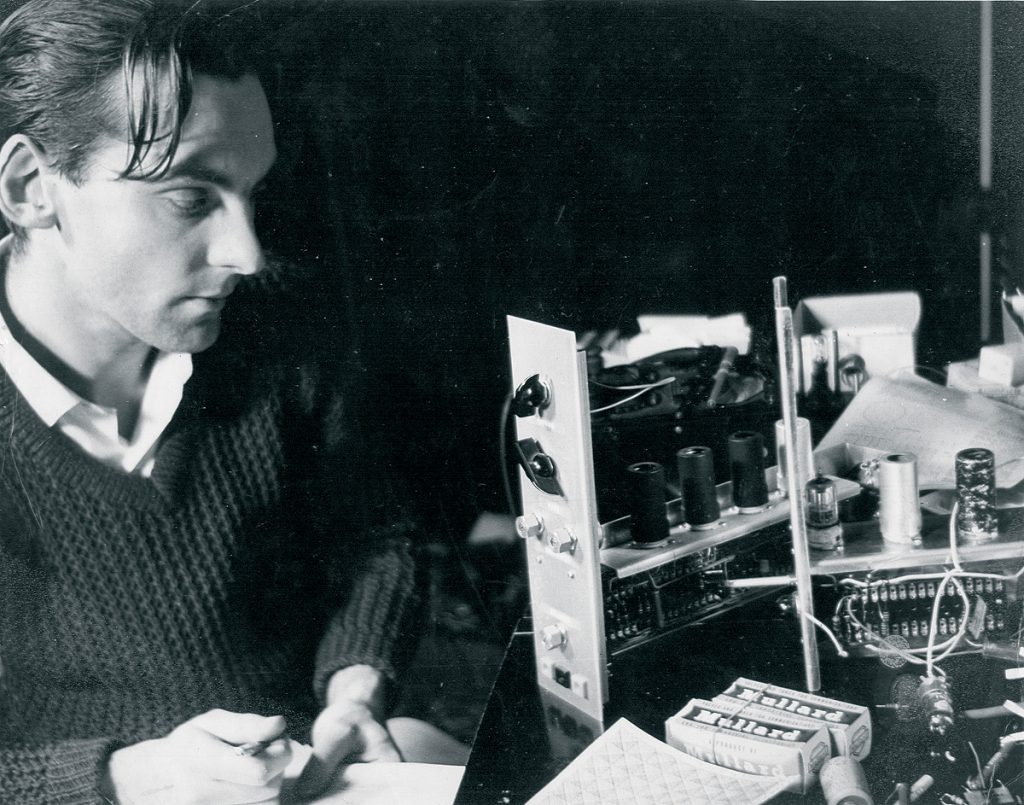
We could not have grown this community of enthusiasts without Facebook, but using the services of an external party also means there is no control over the way these services evolve. Since the page was established, Facebook has altered the layout of pages. Comments made by others are no longer placed among the Museum’s content, but in a separate small box at the top. It is likely that these changes were made to accommodate companies who want to use Facebook as a more traditional marketing tool and who don’t want negative comments taking centre stage on their page, but the changes are limiting if you value content from others as much as (or more than) the content you’ve created yourself.
Online audience 2: the Oramix remix competition
https://dx.doi.org/10.15180/140206/010Many of the electronic music enthusiasts that we encountered online were musicians or DJs. Some of them lived at a distance from London, several abroad. We believed that a remix competition would give these more geographically dispersed audiences the opportunity to engage with the project’s historical content in a creative way. We worked together with Soundcloud, the online audio distribution platform, to run the competition. We also collaborated with the Daphne Oram Trust and record label Boomkat who together manage the rights to Daphe Oram’s work and who kindly provided us with samples. We felt that a request to ‘sample Daphne Oram’s music’ would have been too vague a challenge. Instead we decided to link to content that was being developed for the new gallery on the history of communications, because the two exhibitions addressed overlapping themes. The competition challenge read: ‘Daphne made music for TV shows and commercials […] Imagine that the producer of Our World, the 1967 TV programme that first linked the world via satellites, had commissioned Daphne Oram, the pioneer of electronica, to make its soundtrack.’[19] To promote the competition, we worked with music magazine The Wire, as well as Sound and Music, an agency promoting and supporting UK contemporary music. The musicians Brian Eno and DJ Spooky and an editor from The Wire were our judges. Prizes were made available, but it is likely that most contestants were drawn by the challenge of working with Oram’s material and contact with the judges, rather than the prizes. Contestants were generally supportive of each other and commented on each other’s pieces, but also pointed out and commented on sections of the samples they were provided with.
The practical organisation of the competition was quite complex, because so many partners were involved.[20] Communication with our audience also proved to be more of a challenge than it was for the Facebook page. Several people sent us messages through Soundcloud with questions and concerns. Others approached us through Facebook. All these people spent hours working on their tracks and cared greatly about the competition. This meant it was even more important to us to communicate with them in a clear and open way.
The remix competition was much more successful than expected, with 150 entries submitted, leading to considerably more work for the Museum team than anticipated in producing the judges’ short list. The 22 tracks in the shortlist were chosen on the basis that they best respected the terms of the competition, especially in making creative and audible use of the Oramics samples; they ranged in style from melodic electronica to the kinds of musique concrête that Oram would have recognised. The winner selected by the sum of the judges’ scores was Chris Weeks with Telescopic Moon.
The whole experience showed us that engaging people online involves time and commitment. However, it also taught us that it is worthwhile to open up to the enthusiasm and knowledge of people outside our organisation. When an organisation is open with people about the way it works and is willing to share not just what is meaningful to itself, but also what is meaningful to its audience, people will share unexpected things with the organisation as well. It is precisely this unexpectedness that speaks to our public history programme’s concern to understand better how visitors think.
Conclusions
https://dx.doi.org/10.15180/140206/011We suggested above that museum displays always express the particular accounts of their subject chosen by their authors. In Oramics to Electronica, we set out to make an exhibition that expressed this in the form of a ‘polyphonic’ exhibition; one that contained within itself several different subjective accounts of the early decades of electronic music in Britain. We have also stressed that within constructivist accounts of museums, visitors view exhibitions in ways that enable them to construct their own accounts of subjects. These accounts are different from visitor to visitor, and more detailed where the visitor’s enthusiasm for, and knowledge of, the subject depicted is greater. Undoubtedly, for example, one of the pleasures of exhibition visiting occurs when an audience member’s prior understanding is reinforced; for the visitor to see that the museum ‘gets right’ a subject in which he or she has an intellectual investment enhances a sense of belonging. For some visitors, an exhibition on electronic music will not particularly register; in others, such a display will reinforce, contradict, even infuriate existing expectations. All these are valuable forms of engagement. But a museum visit will always be a complex encounter because everyone is a member of many micro-audiences, by virtue of life lived and aspects of society, history and culture encountered. In our case, not all will have a developed enthusiasm for electronic music, but as members of the UK audience they will have encountered its use in specific circumstances; on the dance floor, or while watching Doctor Who, for example. An enthusiastic ‘Whovian’ may be disappointed by the display, as it features no objects used in the recording of the series’ theme tune, but perhaps they are also a Manfred Mann fan, and delighted to see his contribution recognised in one of the exhibition’s photographs. Or, falling into nostalgic mode, they spy Hugh Davies’s egg-slicer and – amused by the thought of it as a musical instrument – they also recall an era of cuisine that demanded significant quantities of sliced boiled egg.
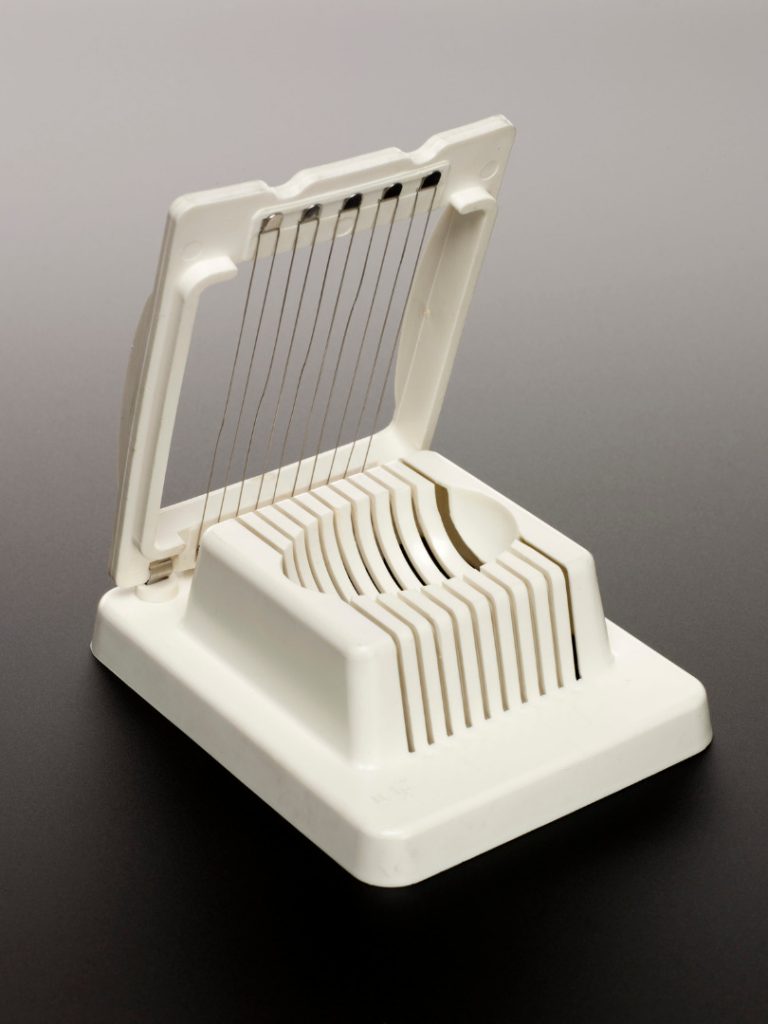
Leaving the exhibition behind they might (for a period in 2013) have wandered into the adjacent gallery and encountered photographs by Tony Ray-Jones of their home district in the 1960s in the temporary exhibition Only in England. This imagined visitor is a member of each of these micro-audiences – Doctor Who and Manfred Mann fan, survivor of 1970s cuisine, child of rain-drenched 1960s seaside resort – and many more besides. It is on this basis, we propose, exhibitions make sense to visitors.
The different groups enrolled in this co-curation experiment produced not only successful displays – the exhibition will have had more than three years of public exposure by the end of 2014 – but also public historical insights. The technique of using co-production not primarily as a means of social inclusion, but for insights into how audiences think about the subjects and objects we display, has been productive. For the original participants, the collaboration was very much on the level of equals, with groups having an investment in conveying their sense of their own history. For the group of recruited electronic music enthusiasts, pleasure that the Museum wanted to represent the subject of their enthusiasm matured into a strong commitment to ensuring that what they see as a true account was included in the exhibition. The NYT students brought a resistant mindset to the project; their final performance narrated their coming to terms with the Museum, and also with styles of electronic music outside their taste, through identification with Oram as an ‘outsider’. The women writers found in Oram and her Oramics Machine the grounds to reflect on varied circumstances of power, isolation and communication. The online circles of participants expressed their subjective response to the project, to Oram, and to the machine, in many ways. The remix contribution extended the specifically musical engagement in the project, enabling entrants to bring their musical sensibilities to bear on the music that is a core concern of the show. Facebook users and bloggers surrounded the project with comment, criticism and support, all rendering visible the ways in which audiences respond to what they encounter here.
The experiment described here suggests many further research questions and avenues of investigation. One clear point is that the different voices within this show’s ‘polyphony’ are still in harmony; there are no strong disagreements between the accounts expressed in Oramics to Electronica; they are complementary. It would be valuable to explore a more controversial theme using a public historical approach, where accounts would be likely to be contradictory.[21] Energy supply, including the nuclear question, might be such a subject. Making such disagreement the focus for public debate around a historical display within the Museum could allow the Museum another avenue for bringing dialogue and debate into the heart of its exhibition offer, though this time addressing the past’s salience to present debates, and showing the relevance of core historical collections to visitors and issues today.
The project also demonstrated for the Museum that working ‘upstream’ with lay groups can be highly productive not only because of the public history questions it answers, but for the practical results it produces. The success here, for example, enabled a co-collecting project in which three of the Oramics participants joined the 2014 action research project into what music technology the Museum should collect. This latter experiment showed once again that the expertise of micro-audiences can be highly valuable to the Museum.[22] Micro-audiences, it turns out, may often be similar to curators with respect to their areas of knowledge and enthusiasm. This is not a threat to curatorship, but an invitation to develop curatorship’s repertoire to embrace various kinds of participation in the more effective delivery of the core functions of museums, in recognition of the fact that we curators are members of the societies and cultures we represent.
Acknowledgements
The Science Museum and the authors would like to record their indebtedness to the participants in this co-curation experiment and the organisations that supported the work in many ways.
Tags
Footnotes
Back to text
Back to text
Back to text
Back to text
Back to text
Back to text
Back to text
Back to text
Back to text
Back to text
Back to text
Back to text
Back to text
Back to text
Back to text
Back to text
Back to text
Back to text
Back to text
Back to text
Back to text
Back to text

